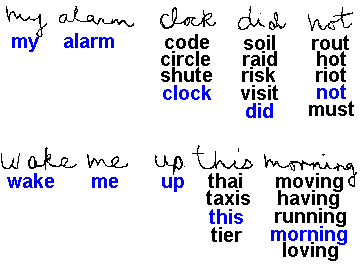This research focuses on the use of human language models in performing handwriting recognition. Systems for handwriting recognition are referred to as off-line or on-line systems, depending on whether ordinary handwriting on paper is scanned and digitized or a special stylus and a pressure-sensitive tablet are used. In both, the ultimate objective is to convert handwritten sentences or phrases in analog form (off-line or on-line sources) into digital form (ASCII).
Due to variability in handwriting styles and distortions caused by the digitizing process, even the best handwritten word recognizer is unreliable when the number of word choices is large. This necessitates the use of linguistic constraints (which employ sentence-level context) to achieve a performance level comparable to that of humans.
There are three parts to the research: (i) adapting existing language models, (ii) developing new language models suitable for this application (such as hybrid language models which are more powerful than n-gram models but avoid the computational overhead associated with context-free grammars), and (iii) effective design and use of training corpora and lexicons which is necessary because language employed in handwritten text tends to be informal and ungrammatical.
The value of the research will be demonstrated by incorporating the improved language models into actual handwriting recognition systems- both on-line and off-line. Performance metrics will show the utility of accurate language models by measuring recognition accuracy as a function of the amount of linguistic processing required.
The research holds promise for pen-based human-computer
communication, handwritten document recognition and understanding
the role of language in interpretation of writing.
Example of Processing a Handwritten Sentence
The results of doing offline isolated word recognition are shown in the image below. Under each word, we have listed the top (upto) 5 choices of the offline handwritten word recognizer, with the correct choice being highlighted.

Using language models incorporating collocational (alarm clock) and syntactic (POS) analysis, we are able to extract the correct sentence:

